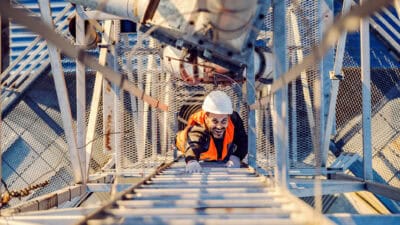Curious about the outlook for the Australian economy and ASX share prices in 2021?
We are too.
Which is why we dialled into AMP Capital's – a subsidiary of AMP Ltd (ASX: AMP) – webinar earlier today.
The webinar featured Shane Oliver, head of investment strategy and economics and chief economist at AMP Capital, and Diana Mousina, senior economist at AMP Capital.
Share markets lead the charge
When the extent of the global pandemic began to dawn on investors, share markets the world over crashed hard and fast. In the matter of a month the S&P/All Ordinaries Index (ASX: XAO) plummeted 37%, hitting its low on 23 March.
While that rapid plunge caught most investors off guard, the pace of the rebound was even more surprising. The All Ords is now back in positive territory for the year and US markets are posting new record highs.
"Maybe share markets have run ahead of themselves, but they've done what they often do. They fell out of bed in anticipation of the economic hit of the shutdowns… and they've rallied in anticipation of the recovery," said Shane.
Can that rally continue into 2021?
Yes, according to Shane. He points to continued low interest rates, massive amounts of stimulus, investor hopes for the reopening and a return to some sort of normality in 2021–22, and pent-up demand as factors likely to drive further share price gains in the year ahead.
AMP does not expect the Reserve Bank of Australia (RBA) to raise rates for at least 3 years, while it forecasts that global monetary and fiscal stimulus will remain large.
According to Diana:
The RBA is likely to keep interest rates where they are now and continue with its quantitative easing program because the rest of the world is doing the same thing. If they weren't purchasing more government bonds, you'd see even more upward pressure on the Australian dollar, which has already been appreciating over the past few months.
The outlook for dividends
With term deposits paying an average rate of around 0.5%, investors are increasingly eager for ASX dividend-paying shares. While those dividends have also slipped, Shane says 2021 should see an uptick, which in turn should support share prices:
As we go through 2021, I reckon the dividends will start to go back up again… We're looking at dividend payment on the Aussie market over the next 4 months of somewhere between 4–4.5% [up from the recent 2.9%].
He added that the higher income on offer should keep money heading into the share markets: "Our indicators for Australia are now looking healthier than they are in Europe and the US."
Australia's positive economic outlook in 2021
Explaining why she has a positive view for Australia's economic performance in 2021, Diana pointed to a number of factors.
First, the Aussie government stepped up with large fiscal spending packages, including JobKeeper and the upgraded JobSeeker. At around 11% of GDP, the fiscal spending splurge was on the high end of comparable nations.
Second, Australia's success at controlling the virus puts us on solid footing as we head into 2021.
According to Diana:
Overall Australia will probably do better than the rest of the world in 2021… The fiscal stimulus will dwindle. JobKeeper is likely to be wrapped up after March. We could get some more tax cuts coming through next year, which would stimulate households. And some changes around stamp duty in New South Wales, which other states could follow. And there's still a really big pipeline of state infrastructure projects which tend to be very positive by generating a lot of jobs. That has a big multiplier impact on the economy.
Diana reiterated that AMP believes the Australian share market will likely to do better over the next 6–12 months compared to the rest of the world.
Should Australia be worried about its ballooning debt?
Diana isn't overly concerned about the mounting government debt, saying it's sustainable, for now:
If your level of economic growth is much higher than the interest you're paying on that debt, then you can sustain these very high levels of debt for some time. You should be able to grow your way out of this debt.
She adds:
The rest of the developed nations have much higher levels of net debt positions… Just because you have high levels of debt doesn't mean that bond yields will go higher, as you can see in the US.
As long as bond yields remain low, the interest the Aussie government has to pay on its debt will remain manageable.
The outlook for inflation
Of course, the one thing that could force the RBA to increase interest rates, and make servicing the growing debt pile more costly, would be a ramp up in inflation.
However, AMP doesn't expect any broad inflation issues next year.
Diana noted that there will be some "pockets of inflationary pressure" due to higher prices for certain goods as well some restaurants charging more for dining out due to restricted capacity and higher cleaning costs. But she said those pockets of higher costs will be kept in check by the spare capacity in the labour market, which AMP doesn't see returning to near full capacity until end of 2021 or into 2022.
And the Aussie dollar?
Currently trading above 74 US cents, the Australian dollar has been unexpectedly strong. That's driven by high commodity prices, with iron ore trading for more than US$140 per tonne, and a weaker US dollar. A weaker greenback is often tied in with better global growth.
AMP forecasts that the Aussie dollar will be worth around 80 US cents by end of 2021. On the lower bound, Diana said, "It's hard to see it moving below 70 [US] cents, even with the RBA continuing its QE program."
Property's surprising resilience
If you listened to the doomsayers back in March and April, you may well have sold your family home and run for the hills.
Yet here we are in December and property prices in many areas are reporting strong growth.
As Shane says, "If you take the whole housing market, it's been a big surprise. Much like the broader economy surprised on the upside for the second half of the year, so too has the property market."
He explains that lower interest rates and a range of protective income measures from the government have largely managed to offset the drag from higher unemployment and lower immigration.
However, Shane points out that lower immigration will have a continuing negative impact on some property markets, particularly in city areas where "apartment units are somewhat vulnerable next year".
He expects this will mainly be an issue in Sydney and Melbourne, saying "generally, the property market should do well next year."
What can we expect when the government winds back its stimulus?
As with the property market crash that never materialised, the fears of government stimulus packages winding down causing share markets to crash is overblown, according to Diana:
[T]he recovery is well on track… Our state borders are now opening up. The majority of restrictions have been lifted. The majority of business can now operate close to normal… The savings rate is extremely high in Australia, at around 18%, while before COVID it was around 4–5%. So, there's a huge pocket of money people can use to spur consumption going ahead.
Diana also noted that while JobKeeper will likely end in the first quarter of 2021, the government is likely to keep the JobSeeker level "a bit higher" than pre-COVID levels.
Speaking of stimulus…
One of the questions investors want answered is whether the next round of US government stimulus, which has yet to pass, is already factored into share prices.
Diana said that's somewhat dependent on whether Republicans hold onto the Senate in January's by-election. Should Democrats win control of the Senate, they'll hold both houses and the White House under Joe Biden. That will mean a much larger stimulus package, and likely a bigger boost for share prices.
Either way, she believes the stimulus package has only been partly priced into markets:
When it is passed, I do expect that share markets will have another leg up. Because there's always some concern that it may not get there… Of course, if you don't see it getting passed, that will be a negative for share returns.
What can we learn from 2020?
Looking back on 2020, Shane said it's reinforced his views to "invest for the long term":
The noise has become more intense. There's something new every day now. It's a lot harder to keep up as an investor. It's important to turn down the noise… And [2020 reinforced] how hard it is to try to time the bottom… The big surprise was how quickly things turned around to the upside. So, invest for the long-term. Don't get too hung up with short-term swings.









